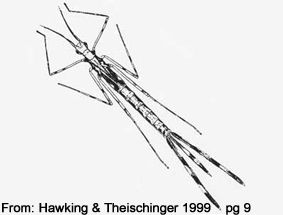Major Group: Insecta
Order: Odonata
Family: Calopterygidae
Genus: Neurobasis
Species: australis
This family is represented in Australia by a single species, Neurobasis australis. Nymphs from this family are unknown in Australia. The description below is based on the Asian and New Guninean species. |
Descriptive Features: labium flat, lacking major setae, median lobe deeply cleft
labial palps narrow with 3 sharp distal teeth
pedicel of antenna enlarged
abdomen usually slender;
gills elongate, median gill lamellate, lateral gills triquetral
Total length: |

|
Neurobasis chinensis from Papua New guinea |
|
|
|
Taxonomic Checklist:
Neurobasis australis Selys, 1897 |
|
Distribution: N Qld is the expected distribution, nymphal specimens have not been collected in Australia this century or the last.
Sensitivity Rating: none
Functional Feeding Group: predators |

|
tributary of Barron River, Kuranda Qld |
|
|
Ecology: Adults are commonly known as 'demoiselles'.
Instream habitat: Neurobasis australis occurs in lotic waters. Australasian Neurobasis species are found amongst gravel and rocks in clear, fast flowing creeks, streams and rivers, mostly within forested areas
Feeding ecology: Nymphs are predators.
Habit:
Life history: Australasian Neurobasis males are territorial and defend potential oviposition sites. Females usually lay their eggs on submerged floating root mats or plants, usually at a depth of 5-15 cm below the water surface. |
| |
Information Sources: Houston 1988, Gunther 2006, Michalski 2006, Theischinger & Hawking 2006 |
|
|
|